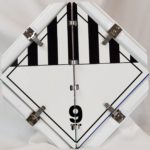A question from someone who had recently attended one of my USDOT/PHMSA HazMat Employee Training Webinars (05.17.18):
Hi Daniel!
We have a product in totes (Product Name part A, ###A) which is a DOT HazMat class 9 (UN: NA3082, PG III, liquid) with an RQ of 11,111 lbs. In Section 14 of the SDS it states: “When in individual containers of less than the Product RQ, this material ships as non-regulated” – I’m not sure what this means. The product is shipped in totes/IBC (each approx. 3300 lbs – 330 gal) with about 4-6 per load.
My question is: does a semi truck trailer need to be placarded (class 9) when shipping about 4-6 totes (total max ~22,000 lbs; in bulk and >1,001 lbs)? According to your USDOT/PHMSA HazMat Employee training webinar I recently attended, placarding is required for any materials from Table 2 in bulk package (>119 gal) or >1,001 lbs. Also, on page 3 of the DOT Chart 16 (handout) it states for CLASS 9: “(Placarding) Not required for domestic transportation”.
Could you clarify this? No need to elaborate much, I’m just looking for the quick answer. The confusing part is the SDS statement…. and Chart 16.
Thank you very much!!
Contact me with any questions you may have about the transportation of hazardous materials by air, highway, vessel, or rail International and Domestic Daniels Training Services, Inc. 815.821.1550 |
A quick reply based on the available information:
Please see below.
- Section 14 of the SDS cannot be relied upon for a hazmat classification. Read: Section 14 of the SDS, can it help with your HazMat Classification?
- I am not aware of any hazardous substance with a reportable quantity (RQ) of 11,111 lbs. I believe the max RQ is 5,000 lbs.
- It would be helpful to know the constituent in the product that is a hazardous substance. Can you provide an SDS for the product?
- I won’t know for certain without seeing the SDS but I am confident the statement in section 14 is indicating that the material is not regulated as a HazMat unless it is a RQ of a hazardous substance.
- If I knew the name of the HazMat and its concentration in the solution, I could determine if an RQ of a hazardous substance is present.
- The Class 9 Miscellaneous placard is not required within the U.S.
I think a quick review of the SDS would indicate if a hazmat or not.
He was able to provide additional information:

Here is page 1 and page 10 of the SDS. Sorry for the poor quality of the image.
Thanks again!
- Text from section 14 SDS reads: “Additional Transportation Information: When in individual containers of less than the product RQ, this materials ships as non-regulated.”
- The hazardous substance component of the product was 4,4′-diphenylmethane Diisocyanate (MDI). It has a RQ of 5,000 lb.
- The information provided did not identify the concentration of MDI in the product.
- As noted in the previous email, it is not required to display the Class 9 Miscellaneous placard in the U.S.
My reply:
Please see below. My response is based on the information provided.
- Do not rely on section 14 of this SDS. In this SDS it contains several errors. Unfortunately, this is not uncommon in my experience.
- The product is only a hazardous substance if at a concentration of 10% or more in the solution and has a mass of 5,000 lbs (454 kg) or more in a single container. This is not possible in a single IBC of 3,300 lbs.
- It does not appear to be a HazMat for any other reason that I can determine. However, it may contain other HazMat I am not aware from the information provided.
Like this article? Subscribe to my Monthly Newsletter No marketing emails! |
He sought confirmation:
No need to placard trucks transporting this material then. Thanks for the clarification.
My final answer with a suggestion:
No, however, I do think this deserves more research. In my experience at least one of the two parts of a resin system are a HazMat.
Conclusion:
But that was the last I heard from him on that topic.
